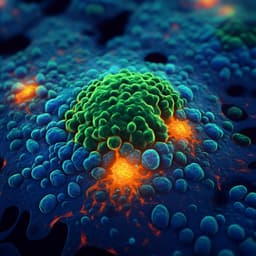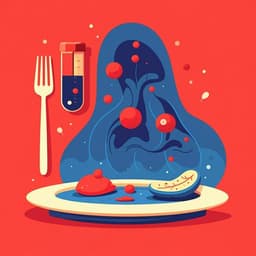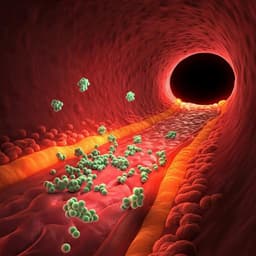
Physics
Time-resolved optical shadowgraphy of solid hydrogen jets as a testbed to benchmark particle-in-cell simulations
L. Yang, L. Huang, et al.
Explore groundbreaking advancements in particle-in-cell (PIC) simulations from a dedicated team including Long Yang and Lingen Huang. This research introduces a novel testbed for subrelativistic intensity modeling using laser-irradiated cryogenic hydrogen-jet targets, unveiling crucial insights for plasma kinetics in ultrarelativistic laser interactions.
~3 min • Beginner • English
Introduction
High-intensity laser-solid interactions underpin applications in fusion fast ignition, laser-driven ion acceleration, warm dense matter creation, and secondary radiation sources. While PIC simulations accurately capture ultrarelativistic regimes (a0 > 1), the transitional and subrelativistic regimes (a0 ≤ 1; 10^16–10^18 W cm−2 at 800 nm) involve correlated and collisional physics that strain current modeling approaches. Typically, target pre-expansion is treated hydrodynamically over long picosecond scales and PIC covers the ultrafast peak interaction; however, a unified, quantitative benchmark across the transition is lacking. The authors pose the question of how to experimentally derive a macroscopic, time-resolved observable that can serve as a robust endpoint to benchmark PIC predictions for laser-solid interactions at a0 ≤ 1. They propose a standardized testbed using cryogenic hydrogen microjets and time-resolved optical shadowgraphy to infer the bulk-electron temperature evolution, enabling direct comparison with PIC and supporting improvement of modeling in this critical transition regime.
Literature Review
Prior work models ultrarelativistic laser-solid interactions including target pre-expansion either by single PIC runs for short leading edges or staged hydro+PIC for long pre-pulses. In the subrelativistic regime, two paths are pursued: extending hydrodynamics tools and augmenting PIC with collisional/correlated physics. Isochoric heating of solids by ultrashort lasers is a well-established route to generate warm/hot dense matter; electron heating mechanisms transition from vacuum heating to resonance absorption depending on surface-density scalelength and intensity. Conventional bulk electron temperature diagnostics employ time-integrated x-ray spectroscopy; optical shadowgraphy has been used for lower-Z targets to visualize expansions. The work situates itself among these, proposing an optical, time-resolved benchmark observable (bulk Te evolution) tied to macroscopic density evolution, leveraging the simplicity of a pure hydrogen target to compare with analytics and simulations.
Methodology
Testbed and experiment: A testbed was implemented at the DRACO-150 TW laser (HZDR). The pump beam (λ=800 nm) with energies up to 160 mJ and pulse durations from 37 fs to 12.6 ps (AOPDF and SF6 glass options) is focused with f/16 OAP to a 14 µm FWHM Airy spot. A continuous cryogenic hydrogen microjet (aperture 5±1 µm; mean diameter at interaction 4.4±0.2 µm) forms a solid target with fully ionized electron density 5.2×10^22 cm−3 (~30 n_800nm). Off-harmonic, two-color optical shadowgraphy at 90° uses synchronized 258 nm (0.3 µJ, 260 fs) and 515 nm (5 µJ, 160 fs) probes focused with f/1 OAP into an imaging microscope (NA 0.55 objective, dichroic separation, matched filters). Due to dispersion, the 258 nm probe lags the 515 nm by 4.6 ps. Spatial resolution: <500 nm at 258 nm (M=77; FoV 84×63 µm^2), <1 µm at 515 nm (M=70; FoV 190×190 µm^2). A time-delay scan (5 ps steps) at ELaser=160 mJ, τ=37 fs, I=1.6×10^18 W cm−2 was performed; shadow diameters D_258nm and D_515nm were measured at the pump focal position. Volumetric transparency onset defined when sharp edges vanish (D set to 0).
Hydrodynamics (HD): FLASH (2D radial symmetry, two-temperature) with hydrogen FPEOS computes adiabatic expansion from initial conditions parameterized by bulk electron temperature Te0, ion temperature T_i0≈10 eV (weak influence), and initial plasma diameter D0 (sensitive, varied within experimental uncertainty). Vacuum density is 1e−8 of target; box length 50 µm. Electron and ion temperatures equilibrate by ~10 ps; surface density evolves toward an exponential with increasing scalelength.
Ray tracing (RT): For each FLASH-derived ne(r,t), refractive index ñ(x,y)=sqrt(1−ne/nc(λ)) is computed for λ=258 and 515 nm. A virtual optical setup (Zemax) reproduces the microscope (NA 0.55). Rays refract through the gradient index field; image-plane intensity yields shadow with sharp edges and fringe brightening. Shadow diameter Dλ is taken at 50% of background. When volumetric transparency occurs, Dλ is set to zero.
HD-RT fitting and χ2: A grid of FLASH initial conditions scans Te0=100–350 eV (50 eV steps) and D0=3.0–5.0 µm (0.5 µm steps). χ2(Te0,D0)=Σ_{t,λ}(De−Ds)^2 compares experimental Dλ(t) to simulated Dλ(t,Te0,D0). Two minima identified: case α (Te0=250 eV, D0=3.5 µm) and case β (Te0=300 eV, D0=4.0 µm). The fitted Te0 represents the heuristic initial bulk-electron temperature at 0 ps for subsequent adiabatic cooling.
PIC simulation: PIConGPU (2D3V) models laser-solid interaction including relativistic binary collisions. Target: fully ionized hydrogen column with density profile n(r)=n0[(r−rc)+(-rc)exp(−r/L0)]^{−1/α}, with n0=30 n_800nm, D0=4.4 µm, surface scalelength L0=0.25 µm (mean experimental estimate), mass-conserving reduced radius rc=√(D0^2−L0^2). Initial temperatures 0.1 eV; initial surface plasma length 10×L0. Laser: Gaussian, τ=37 fs FWHM, 14 µm FWHM spot, y-propagating, x-polarized. Domain 32×32 µm^2, Δx=0.8 µm/96, 240 macroparticles/cell, absorbing boundaries. Outputs: bulk electron temperature Te via Maxwellian fit within r≤2 µm, directional kinetic energies Tx,Ty,Tz, and density/temperature spatiotemporal evolution. Additional scans varied surface scalelength L0 (0–500 nm) and Coulomb logarithm lnΛ (3.5–15); 3D checks assessed dimensional effects and lateral diffusion. Radiative cooling and low-temperature collision corrections were analyzed analytically and via FLYCHK.
Key Findings
- Time-resolved two-color shadowgraphy shows increasing shadow diameters D_258nm and D_515nm with delay until volumetric transparency. Transparency onsets at ~22.5 ps (258 nm) and ~47.5 ps (515 nm) in simulations that match experiment; experimentally observed between 20–25 ps and 45–50 ps, respectively.
- HD-RT fit to measured Dλ(t) yields a heuristic initial bulk-electron temperature Te0 between 250 eV (D0=3.5 µm) and 300 eV (D0=4.0 µm) at 0 ps; subsequent adiabatic cooling captured by FLASH reproduces Dλ trends for tens of picoseconds.
- PIC (PIConGPU) shows isochoric bulk heating: Tx,Ty peak at ~20 keV at 67 fs while density remains near-initial through 0.2 ps; thermalization of bulk electrons occurs by ~1.5 ps as Tx≈Ty≈Tz.
- After thermalization, PIC-predicted bulk Te exceeds HD-RT-inferred Te unless initial surface scalelength is accounted for. Systematic PIC scans attribute the discrepancy primarily to the initial surface-density scalelength L0.
- Strong dependence on L0: At 1.8 ps, bulk Te decreases from 1087 eV (L0=0 nm) to 353 eV (L0=500 nm), almost a factor of 3 reduction; exponential decrease suggests saturation at large L0.
- Mechanism transition: Increasing L0 reduces forward hot-electron current (peak from 32.4 to 10 kA µm−2 for L0=0→500 nm) and shifts absorption from vacuum heating (small L0) to resonance absorption (large L0); coronal plasma temperature increases with L0 while bulk heating decreases.
- Sensitivity checks: Changing Coulomb logarithm lnΛ from 15 to 3.5 reduces bulk Te at 1 ps by ~20%; 3D vs 2D3V differences are ≤~1.7% between 0.2–0.4 ps; radiative cooling of hydrogen is negligible (<0.1% Te reduction within 2 ps); low-temperature collision corrections affect only pre-peak times and do not alter post-thermalization Te.
- Hydrodynamic applicability confirmed: Knudsen number ~0.02, weak coupling, weak magnetization; FLASH EOS choice (FPEOS vs SESAME) yields consistent density evolution.
Discussion
The study introduces a standardized experimental-simulation testbed for laser-solid interactions at a0 ≤ 1, using a simple hydrogen target and macroscopic, time-resolved observables to benchmark PIC predictions. By fitting hydrodynamic expansion (FLASH) and optical ray-tracing (Zemax) to measured shadow diameters, the bulk-electron temperature evolution after heating is inferred without invoking detailed laser-heating models. Comparing this to PIC highlights the importance of initial surface-density gradients: quantitative agreement after thermalization (~1.5 ps) requires accurate target surface conditions. Systematic PIC scans identify the initial scalelength L0 as the dominant factor governing post-thermalization Te, via a transition from vacuum heating to resonance absorption that alters hot-electron currents and bulk return-current heating. Lesser influences stem from uncertainties in lnΛ, dimensionality, and radiative cooling. These results both validate the testbed’s endpoint (bulk Te(t) post-thermalization) as a robust benchmark and emphasize precise characterization of initial density profiles in simulations intended to match experiments. The approach enables controlled parameter scans across subrelativistic intensities and can be extended to probe non-thermal coronal dynamics by adapting probe wavelength.
Conclusion
The work proposes and demonstrates a testbed to benchmark PIC simulations of laser-irradiated solid-density targets using micron-scale cryogenic hydrogen jets and two-color, time-resolved optical shadowgraphy. A hydrodynamics-plus-ray-tracing fit (HD-RT) to measured shadow diameters provides the bulk-electron temperature evolution after heating; for a 37 fs, a0≈1 case, Te0=250–300 eV is inferred, with thermalization by ~1.5 ps and subsequent adiabatic cooling. Comparison with PIC reveals strong sensitivity to the initial surface-density scalelength, which governs electron-heating mechanisms and thus bulk Te. The testbed is shown to be robust and general, supporting quantitative benchmarking of PIC, and is ready for controlled scans at a0 ≤ 1 (down to ~10^16 W cm−2) and for future extensions to higher intensities, alternative probe wavelengths (e.g., near-IR to access coronal densities), and different cryogenic materials (e.g., H/D mixtures, argon) and heating sources (e.g., laser-driven ion beams).
Limitations
- Diagnostic sensitivity: The 258 nm and 515 nm probes are sensitive to densities near ~0.1 nc for their wavelengths, thus they do not image the low-density hot coronal plasma (0.1 n_800nm to 10^−3 n_800nm). Additional probe wavelengths are required for coronal benchmarking.
- Temporal resolution: Snapshots are blurred by the probe pulse durations (160–260 fs), and a fixed 4.6 ps timing offset exists between probes due to dispersion.
- Target variability: Shot-to-shot fluctuations in jet diameter/aspect ratio and bowing introduce variations in Dλ; rapid freezing induces compositional/structural variations. Pump-laser peak power fluctuates (~12%).
- HD-RT assumptions: Assumes homogeneous initial bulk Te (isochoric heating) and models expansion hydrodynamically with radial symmetry, excluding explicit laser heating; lateral heat diffusion and 3D effects are shown to be minor but are approximations.
- Simulation assumptions: PIC initial full ionization and chosen L0 introduce uncertainty; 2D3V geometry neglects some 3D dynamics (minor in tested ranges); binary-collision model and Coulomb logarithm approximations impart ~20% uncertainty; radiative processes are neglected (justified for Z=1).
- Dependence on initial surface profiles: Accurate knowledge of the initial surface-density gradient is critical for quantitative agreement, yet is challenging to measure directly.
Related Publications
Explore these studies to deepen your understanding of the subject.







